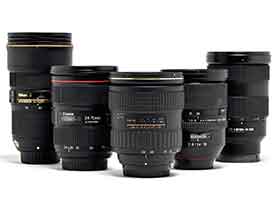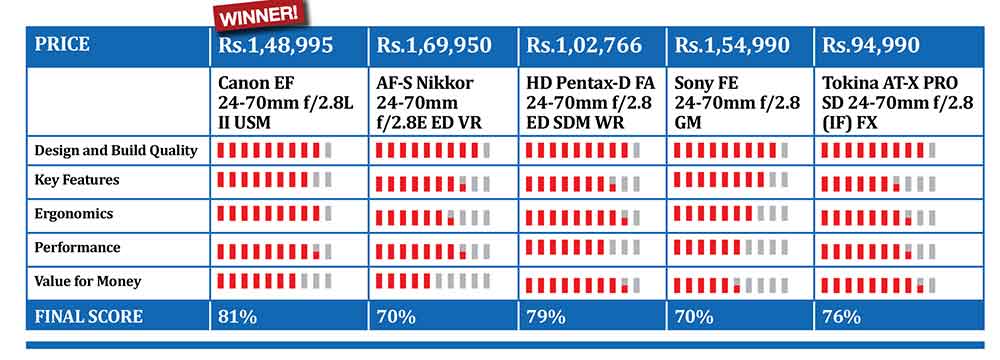 Flare and Chromatic Aberration: To check for flare, we photographed a tree against-the-light, capturing sunlight seeping through the branches. All lenses were kept at the widest aperture (f/2.8). The Sony lens produced the least flare, while the Nikon came second. Both the Pentax and Tokina were comparable at third, while the Canon lens produced the most flare.
Flare and Chromatic Aberration: To check for flare, we photographed a tree against-the-light, capturing sunlight seeping through the branches. All lenses were kept at the widest aperture (f/2.8). The Sony lens produced the least flare, while the Nikon came second. Both the Pentax and Tokina were comparable at third, while the Canon lens produced the most flare.
In the case of Chromatic Aberration, there appeared a reversal of fortunes with the Nikon producing no fringing at all. The Canon lens produced a hint of purple fringing. The Tokina controlled fringing well, but we observed a bit of purple in a small patch. The Pentax produced prominent purple fringing while the Sony produced a very strong blue-violet fringing throughout the frame.
Distortion: For distortion, we used a rectangular grid as a test chart, making sure that the camera’s focal plane is parallel to the subject. We decided to compare the lenses at three focal lengths—24mm, 50mm and 70mm.
At 24mm, all the lenses produced barrel distortion. The Pentax produced the least distortion while the Sony came second with a slight moustache distortion. The other three lenses were fairly even and produced prominent barrel distortion.
At 50mm, both the Tokina and the Canon did not produce any discernible distortion. Nikon and Pentax were comparable with the Nikon producing pincushion distortion and Pentax producing a comparable level of barrel distortion. The Sony produced prominent pincushion distortion.
At 70mm, the Canon, Pentax and Tokina lenses produced fairly clean images. The Sony and the Nikon produced comparable pincushion distortion. Sharpness: Evaluating the sharpness of lenses is the most difficult part of a comparison test. Hence we found the sweet spot (the sharpest aperture for a particular lens) at each focal length and then compared the images at the sweet spots. Also, we did not consider peripheral sharpness because of the difference in depth-of-field due to varying apertures. So all images were compared at the centre, and while shooting, we kept the central focussing point and the focus point was fixed at the same spot. Please note that sharpness depends on the body used as well. We found one camera overexposing the scene even though all the cameras were on Centre-Weighted metering mode and Aperture priority without any exposure compensation applied. We compared the lenses at three focal lengths—24mm, 50mm and 70mm and the average (mean) of the three was taken as the score for sharpness. Canon left all others behind, while Tokina came second with Nikon following at third. Both the Pentax and the Sony shared the fourth slot.
Value for Money
The following are the MRPs of the lenses. But this does not mean that the least expensive is the best lens you can buy. |SP
Representative images
The representative images in these pages have been captured at f/8 so as to negate the effects of shallow depthof- field and diffraction on the reader’s perception. These should not be used to gauge the sharpness of the lens since the sweet spots vary between each lens.
VERDICT
The choice of a lens depends on various factors. Rarely do people choose a body based on a particular lens. However, being the flagship lens for all manufacturers, we trust them to merge their best technologies in a 24-70mm f/2.8 lens. The final results can be used as a guide while selecting a standard zoom lens. The final score is essentially a combination of all the factors including the price. Our pick for the best standard zoom lens currently retailing in Indian market is the Canon EF 24-70mm f/2.8L II USM. If you are on a tight budget, the Tokina AT-X Pro lens
will serve you well.
Sujith Gopinath


